
Bradypodion is one of six genera of chameleons within the "true" or "typical" chameleons. They are native to southern Africa, and are sometimes collectively called South African dwarf chameleons. Some other small chameleons from eastern and central Africa are occasionally placed herein, but this is probably in error and not followed here. See also Systematics below and Kinyongia and Nadzikambia.
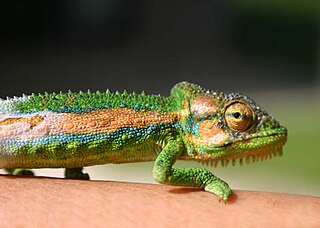
The Cape dwarf chameleon is a chameleon native to the South African province of the Western Cape, where it is restricted to the region around Cape Town.
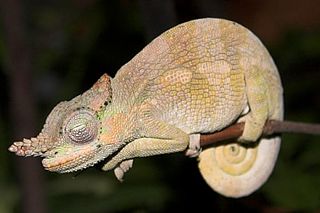
Kinyongia is a chameleon genus recently established for several plesiomorphic species found in forest and woodland in Kenya, Tanzania, Uganda, Rwanda, and far eastern DR Congo. All except K. adolfifriderici and K. tavetana are restricted to highlands, and many have very small geographic ranges. In most, at least the males have horns or knobs on their noses. They had been placed into the genus Bradypodion for some time. It has recently been pointed out that the ending to the specific epithet in several of the below listed species should be modified to match the feminine genus name.
The Zululand dwarf chameleon is a species of lizard in the family Chamaeleonidae. It is also known as the Qudeni dwarf chameleon. It is endemic to South Africa.
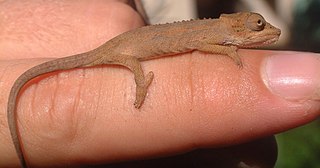
Setaro's dwarf chameleon is a species of lizard in the family Chamaeleonidae.

Smith's dwarf chameleon or the Elandsberg dwarf chameleon is a species of lizard in the family Chamaeleonidae endemic to South Africa. It is one of the few chameleons that uses its color-changing ability to actively camouflage itself.

The Transkei dwarf chameleon or Pondo dwarf chameleon is a chameleon endemic to the Eastern Cape Province of South Africa.

The Robertson dwarf chameleon, also known as the Little Karoo dwarf chameleon, is a chameleon in the genus Bradypodion. It is found in the dry Fynbos and Renosterveld shrub vegetation, in the centre of the Western Cape province, South Africa.
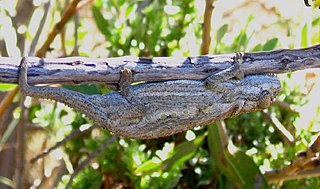
The Swartberg dwarf chameleon is a species of chameleon endemic to South Africa.
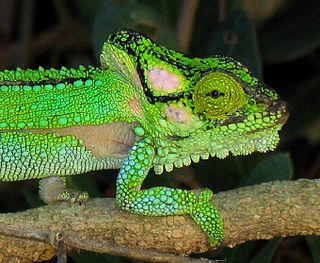
The Knysna dwarf chameleon is a species of dwarf chameleon in the Bradypodion genus that is endemic to South Africa. It is a forest dweller, found only in a limited range in the afromontane forests near Knysna, South Africa, and in certain surrounding areas.

The black-headed dwarf chameleon is a lizard of the family Chamaeleonidae endemic to KwaZulu-Natal, South Africa. It is also known as the KwaZulu dwarf chamaeleon and Durban dwarf chameleon.

Bradypodion ventrale, the southern dwarf chameleon, occurs in the Eastern Cape, South Africa. It is also known as the eastern Cape dwarf chameleon. It is a relatively large species of dwarf chameleon, reaching lengths of 14 cm (5.5 in). It has a very prominent casque on the back of its head and a long, beard-like throat crest. It lives in dense thickets and shrub, and is usually very difficult to spot because of its colouring. It adapts very well to living in suburban gardens, but domestic cats – being introduced predators – will usually kill all chameleons in the immediate area. Consequently, one should not bring chameleons into a garden which is frequented by cats. It gives birth to litters of between 10 and 20 babies in the summer.

The Drakensberg dwarf chameleon occurs in the Drakensberg, South Africa, between the latitudes of 27°45′ and 29°15′. Bright green dwarf chameleons found in the Drakensberg south of 29°15′ are now known to be more closely related to the Natal Midlands dwarf chameleon and may yet be described as a separate species. Picture

The Namaqua dwarf chameleon or the western dwarf chameleon occurs in beach vegetation, along the west coast of South Africa and Namibia.
Ngome Forest is situated to the east of Vryheid, KwaZulu-Natal, South Africa. This is a unique forest, being transitional between Mistbelt Forest and Coastal Scarp Forest. The area has been protected since 1905, and forms part of the Ntendeka Wilderness Area.
The Ngome dwarf chameleon is a species of chameleon found in South Africa.
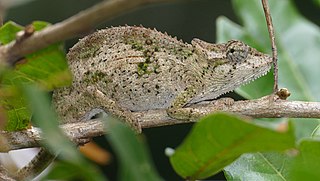
Bradypodion caeruleogula, the Dhlinza dwarf chameleon, Eshowe dwarf chameleon, or uMlalazi dwarf chameleon, is endemic to KwaZulu-Natal, South Africa. It is found in Dhlinza, Entumeni and Ongoye Forests.
The Karoo dwarf chameleon is a chameleon native to South Africa. It is about 14 cm (6 in) long, mostly colored grey and brown, sometimes olive. The thin skin around the throat is yellow, and it has conical scales along the spine.
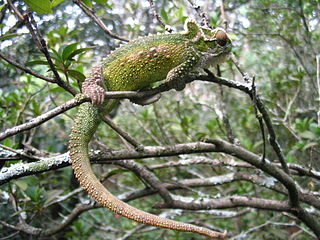
The Natal Midlands dwarf chameleon is a chameleon native to woodland habitat in the inland Midlands area of the South African province of KwaZulu-Natal.
Vivian Frederick Maynard FitzSimons, born in Pietermaritzburg, was a notable herpetologist in South Africa. Also, he contributed to the collection of spermatophyte samples for the National Herbarium which has become part of the South African National Biodiversity Institute at the Pretoria National Botanical Garden. In 1937, together with Anna Amelia Obermeyer, he collected some of the earliest plant specimens from the Eastern Highlands of Rhodesia.


















